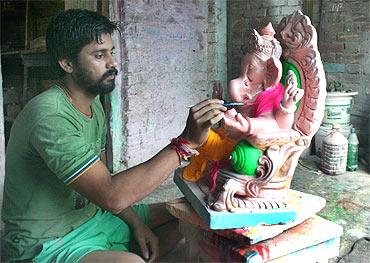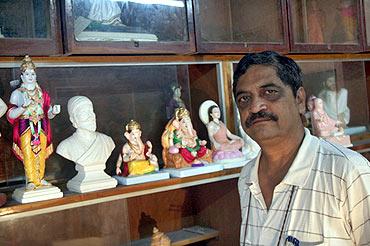Uttam Ghosh and Abhishek Mande travel to Pen, a village in the Sahyadri's, where Ganpati idols are traditionally made.
Situated a little over 80 km from Mumbai, Pen is a small town that like most other small towns in India was once a village. Yet in more ways Pen is a far cry from all those towns, where today swanky cars occupy most of the narrow roads and malls and multiplexes have sprung up.
There are, as far as the eye can see, not many tall buildings. The only tall building stands in the market square, a quasi-administrative structure, rather ostentatiously named after former chief minister Sharad Pawar.
The roads are in poor condition and most residents of Pen continue to use the state transport buses to reach Mumbai. A six-seater contraption called Vikram that accommodates at least a dozen people is the most reliable form of local transport.
For most of the year, Pen is an all but forgotten place, a signboard that you pass while heading to Alibaug, a popular tourist destination for Mumbaikars.
Come Shravan, the holy month of the Hindus, and Pen is tthe cynosure of all eyes. Traffic heading into the town suddenly goes up and along every street corner, vehicles with blue plastic sheets covering their frames stand solemnly, before houses that seem busier than ever.
This is where Ganeshas come to life -- some of them sitting comfortably with a modak in their right hand, others dancing with a little drum, some which espouse a social or patriotic message.
This small town that was once a village is now Ganesha's abode. It has been that way for over 115 years when a few men, having migrated from various parts of Maharashtra made Pen their home.
Image: A traditional Ganpati idol at a workshop in Pen
Photographs: Uttam Ghosh/Rediff.com




Situated a little over 80 km from Mumbai, Pen is a small town that like most other small towns in India was once a village. Yet in more ways Pen is a far cry from all those towns, where today swanky cars occupy most of the narrow roads and malls and multiplexes have sprung up.
There are, as far as the eye can see, not many tall buildings. The only tall building stands in the market square, a quasi-administrative structure, rather ostentatiously named after former chief minister Sharad Pawar.
The roads are in poor condition and most residents of Pen continue to use the state transport buses to reach Mumbai. A six-seater contraption called Vikram that accommodates at least a dozen people is the most reliable form of local transport.
For most of the year, Pen is an all but forgotten place, a signboard that you pass while heading to Alibaug, a popular tourist destination for Mumbaikars.
Come Shravan, the holy month of the Hindus, and Pen is tthe cynosure of all eyes. Traffic heading into the town suddenly goes up and along every street corner, vehicles with blue plastic sheets covering their frames stand solemnly, before houses that seem busier than ever.
This is where Ganeshas come to life -- some of them sitting comfortably with a modak in their right hand, others dancing with a little drum, some which espouse a social or patriotic message.
This small town that was once a village is now Ganesha's abode. It has been that way for over 115 years when a few men, having migrated from various parts of Maharashtra made Pen their home.
Image: A traditional Ganpati idol at a workshop in Pen
Photographs: Uttam Ghosh/Rediff.com




No comments:
Post a Comment